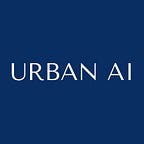Sarah Popelka is a Research Assistant at Urban AI and is currently pursuing a Master’s in Urban Governance from SciencesPo. In this article, she analyzes the insights of our Urban AI Conversation #14 with Robert Heinecke (Breez Technology) and Simas Sodys (Vilniaus planas): “Tackling Air Pollution with Urban AI”
When many people picture smart cities, they think of Internet of Things (IoT)-related data infrastructure: a series of platforms overlaid on a network of sensors, the combination of which collects, transmits, and makes sense of vast amounts of information. Yet, this IoT manifestation of urban technological integration is only one part of the equation. The effectiveness of the technology relies upon a well-defined problem statement and a clear purpose, which the sensors and platforms can be leveraged to solve.
For Robert Heinecke, founder of Breeze Technologies, one urban problem, in particular, lends itself to a sensor-based solution approach: currently, 90% of people across the globe are living in areas with unhealthy levels of air pollution. As our population continues to urbanize (the UN estimates that 67% of the global population will live in cities by 2050), and given the particularly urban nature of pollution (the UN estimates that cities are the cause of 75% of the world’s emissions), the prospects for population health grow increasingly dire. In light of these statistics, Heinecke took up a mission to improve ecological and human well-being. He approaches the ambitious feat of identifying and tackling the root causes of air pollution through the use of data-driven, AI-supported “environmental intelligence” that creates actionable insights based on sensor data.
Air quality monitoring in itself is not a new phenomenon- according to Heinecke, cities began widely installing sensors in the 1970s- but artificial intelligence has enabled a renaissance in the utility and functionality of environmental observation devices. Whereas historically, sensing stations cost prohibitive amounts of money to install, took up substantial space in the public right-of-way, and required massive human intervention to collect and process the data, newer devices come in much more cost-effective and considerably smaller formats, thanks to advances in sensor technology. Additionally, artificial intelligence tools have allowed for the automation of many of the calibration, collection, and processing steps. As a result of these advances, Breeze sensors, and others like them, can be easily deployed throughout a city to sample air quality in near real-time.
The improved spatial and temporal granularity of the variables that Breeze sensors collect (localized temperature and humidity, climate, and pollutant data), coupled with the transparency and insights offered by Breeze’s data sharing/visualization platform, allows for a comprehensive and continuous view into the state of the air. With this information, urban stakeholders working on projects like urban planning, traffic management, chemical transport models, CSR, PR and marketing activities, climate protection activities, and other smart city applications can incorporate an environment-oriented approach to their previously-siloed efforts.
Vilniaus Planas, the planning agency of the City of Vilnius, Lithuania recently adopted Breeze’s sensors to help inform quality-of-life improvements for Vilnius’s residents. Equipped with the rich air quality data provided by the sensors, planning officials are already making progress toward improving happiness and health outcomes in the city. Simas Sodys, the Lead of Innovation for Vilniaus Planas, explains that the choice to tackle air pollution stems from a series of surveys of Vilnius residents, which indicate that air quality factors heavily in citizen satisfaction and happiness. A municipality-calculated resident “happiness index” acts as a key performance indicator that planning efforts in Vilnius seek to improve.
Vilnius’s previous attempts at ameliorating pollution utilized a responsive approach: when a citizen would report poor air quality, the city would send out a technician to collect data and assess the situation. Given time delays between the report and the technician’s arrival, the situation often changed in the interim, making it difficult to identify the root cause of the issue. The integration of Breeze sensor data into Vilniaus Planas’s unified, holistic data visualization environment allowed for a shift to proactive planning efforts. Breeze’s platform facilitates rapid identification of spikes in pollution and provides previously unseen insights into the nature and dynamics of poor air quality in the city, as well as relationships between pollution and other related urban elements.
Looking ahead, Vilniaus Planas has ambitious plans for the use of their smart city sensing and data visualization technologies. For example, through Vilnius’s new interactive mobility map, planners gain a better sense of the complex interactions between infrastructure data, car sharing data, and pollution data. Such insights might eventually allow them to adjust routing options on the fly, through the city’s mobility-as-a-service platform on the fly, in ways that promote shorter commutes, reduced air pollution, and happier residents. With the right approach and adequate data, thoughtful applications of smart city technologies can provide powerful solutions to pressing urban issues.
By Sarah Popelka
